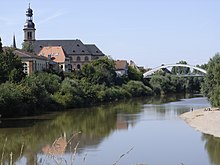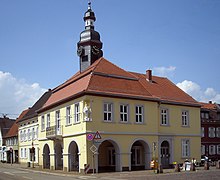Seckenheim
|
Seckenheim
City of Mannheim
|
|
|---|---|
| Coordinates: 49 ° 27 '59 " N , 8 ° 33' 52" E | |
| Area : | 9.42 km² |
| Residents : | 16,406 (December 31, 2015) |
| Population density : | 1,742 inhabitants / km² |
| Incorporation : | 1930 |
| Postal code : | 68239 |
| Area code : | 0621 |
Seckenheim ( Electoral Palatinate : Seggene [ ˈsəgənə ]) is a district of Mannheim in the Rhine-Neckar triangle . Together with the Hochstätt district , it forms the Seckenheim district .
geography
Seckenheim is in the east of Mannheim directly on the Neckar . Neighboring districts are Friedrichsfeld , Rheinau , Hochstätt and Neuostheim . On the other side of the Neckar - to be reached via the Neckar Bridge - is Ilvesheim , which is part of the Rhein-Neckar district .
history
A settlement of the area in Roman times between 74 AD and the early 2nd century is documented by the discovery of a brick kiln .
Seckenheim was mentioned for the first time in 766 in the Lorsch Codex , there a total of 64 times in several spellings. The origin of the place name has therefore not been conclusively clarified; probably is "home of Sikko" and therefore of Franconian origin.
Until 1247 it belonged to the Lorsch Monastery and thus to the Archbishop of Mainz . Then after a violent feud it fell to the Count Palatine Otto II. In 1274 there was a court for the first time. Around 1439 Seckenheim was a wealthy village with 450 inhabitants. On June 30, 1462, during the Baden-Palatinate War, southeast of today's district, the battle of Seckenheim took place , in which Elector Friedrich I decisively defeated his neighbors Margrave Karl von Baden , Bishop Georg von Metz and Count Ulrich von Württemberg and secured his supremacy could.
During the Thirty Years' War , Seckenheim fell to Kurmainz in 1623 and only returned to the Electoral Palatinate in 1651 after the Bergstrasse Recess . In 1682 Friedrichsfeld was founded in the Seckenheim area . In 1768 Freiherr von Stengel built the Seckenheimer Schloss , the park on the Neckar and south of the Stengelhof (today in Mannheim-Rheinau). At the beginning of the 19th century, Napoleon's illegitimate son Léon Denuelle lived here temporarily .
In 1786 there were 1,098 inhabitants. Together with the Electoral Palatinate on the right bank of the Rhine, Seckenheim became Baden in 1803 . The station was built in 1876. The Hochstätt settlement was subsequently built around it . In 1891 the steam-powered narrow-gauge railway Mannheim – Heidelberg was built through the Seckenheimer Hauptstraße, which later became the Upper Rhine Railway .
In 1873, the Rheinau chemical factory was built in the Seckenheim district . A settlement developed around them that developed rapidly (including the Rheinau port ). In 1910 Seckenheim had 5,754 and Rheinau 3,950 inhabitants. This area was separated in 1913 and incorporated into Mannheim. As compensation, Seckenheim received the 225 hectare Kloppenheim field.
In 1911 Seckenheim received a water tower , popularly known as Glatzkopp . Construction of the Neckar Canal began in the 1920s . As a result, the actual Neckar often had so little water that it could no longer be navigated by boats. In 1927, the arch bridge to Ilvesheim was therefore built. In 1930 Seckenheim was incorporated into Mannheim after long negotiations.
The first residential buildings were built in Suebenheim in 1931 . After the Second World War, the United States Army took over the Seckenheim barracks , as well as the former Reichsautobahn restaurant. From 1980, new building areas were developed in the west and south of Seckenheim.
| Population development | 1439 | 1577 | 1777 | 1834 | 1875 | 1905 | 1910 | 1925 |
|---|---|---|---|---|---|---|---|---|
| Seckenheim | 480 | 575 | 990 | 1738 | 3028 | 4776 | 5754 | 6875 |
| Rheinau | 10 | 120 | 3152 | 3950 | s. O. |
Politics, administration
According to the main statute of the city of Mannheim, each city district has a district advisory council, which includes 12 residents who are appointed by the local council according to the results of the local council election. They are to be heard on important matters that affect the municipality and advise the local administration and committees of the municipal council.
| Party / list | 2019 | 2014 | 2009 | 2004 | 1999 | 1994 |
|---|---|---|---|---|---|---|
| CDU | 3 | 4th | 4th | 6th | 7th | 6th |
| SPD | 2 | 4th | 4th | 4th | 5 | 5 |
| GREEN | 3 | 2 | 2 | 1 | 0 | 1 |
| Mannheim list | 1 | 1 | 1 | 1 | 0 | 0 |
| AfD | 1 | 1 | 0 | 0 | 0 | 0 |
| FDP | 1 | 0 | 1 | 0 | 0 | 0 |
| The left | 1 | 0 | 0 | 0 | 0 | 0 |
As one of the eleven outer city districts, Seckenheim has a municipal secretariat, which is responsible for local administrative tasks.
coat of arms
The coat of arms developed from the court seal, which can be proven for the first time in 1573. It shows a canopy that ends in three Gothic pointed arches. Below is an abbot sitting on a throne, holding a crook in his left hand and the gospel in his right. It goes back to the Neustadter St. Agidiusstift. The coat of arms was designed by the heraldist Hermann Grimm, who was born in Seckenheim .
Culture and sights
In Seckenheim there is a branch of the city library, which is housed in the "Old Town Hall", which was built in 1718.
In the listed water tower, the Lochbühler company maintains the elevator museum , a museum on the history of the company and elevator technology. The water tower is also used for conferences and events.
The district is located on the Bertha Benz Memorial Route , which enables everyone to follow the route that Bertha Benz chose for the first long-distance automobile trip in history.
Sports
The indoor pool is almost exclusively reserved for school and club swimming. To the south is a large horse racing track , where the Badischer Rennverein regularly organizes gallop races.
Economy and Infrastructure
Seckenheim has had its own motorway connection to today's A 656 since 1935 .
Tram line 5 (on a section of the former Upper Rhine Railway ) runs through the local area with direct connections to the inner cities of Mannheim and Heidelberg , it is operated by Rhein-Neckar-Verkehr GmbH (RNV). The Mannheim-Seckenheim train station is located in Hochstätt , where the Rhein-Neckar S-Bahn and DB Regio local transport offer fast connections to Mannheim, Heidelberg and the surrounding area. There are also bus connections to the surrounding towns. Seckenheim belongs to the tariff area of the Rhein-Neckar transport association .
literature
- Hansjörg Probst : Alt-Seckenheim. A home book , Mannheim 1993.
- Hansjörg Probst: Seckenheim - Mannheim before the city was founded , Mannheim 2008.
- Kollnig, Karl: Peasantry at the gates of the big city , Mannheim 1935.
- Kollnig, Karl: The history of Seckenheim , Seckenheim 1929.
- Steiner, Gerda: Ma Seggene - Seckenheimer dialect , Zweibrücken 1962.
- Heierling, Alfred: Seckenheim in National Socialism , Mannheim 2012.
- Heierling, Alfred Seckenheimer associations + organizations , Mannheim 2013.
- Heierling, Alfred: Siwwenesibbzischmool Seggene , Mannheim 2014.
- Heierling, Alfred: Seggema ABC , Mannheim 2014.
- Heierling, Alfred: Seggemarisch fa alle das wolle , Mannheim 2014
- Heierling, Alfred: Ausdrigg uff seggemarisch , Mannheim 2015.
- Seitz, Stefan; Urich, Karin (Ed.): 1250 years of Seckenheim , Mannheim 2016
- Heierling, Alfred; Schänne uff seggemarisch, Mannheim 2016
- Heierling, Alfred: Auswäddzisch babbeln, Mannheim 2017
- Rudolf Kreutzer: Seckenheim families 1641 - 1900 . Seckenheim: Schützengesellschaft Seckenheim 1997 (= Badische Ortssippenbücher )
Individual evidence
- ↑ City of Mannheim: Population 2015 in small-scale breakdown. (PDF 679 KB) Statistical data Mannheim № 1/2016. March 30, 2016, p. 5 ff. , Accessed on April 6, 2016 .
- ↑ Hartwig Trinkaus: The jug breaks, but "Seggene" celebrates. SECKENHEIM: The colorful 36th street festival fills barns, courtyards and tents in the “Hunsrück” / weather doesn't really play along on Saturday evening. Mannheimer Morgen, June 18, 2012, accessed on August 25, 2013 .
- ^ Ulrich Brandl and Emmi Federhofer: Ton + Technik. Roman bricks. Theiss, Stuttgart 2010, ISBN 978-3-8062-2403-0 ( publications from the Limes Museum Aalen. No. 61)
- ↑ Minst, Karl Josef [transl.]: Lorscher Codex (Volume 2), Certificate 617 March 14th 766 - Reg. 25. In: Heidelberg historical stocks - digital. Heidelberg University Library, p. 225 , accessed on July 27, 2015 .
- ↑ List of places for the Lorsch Codex, Mannheim-Seckenheim , Archivum Laureshamense - digital, Heidelberg University Library.
- ↑ Hansjörg Probst, Seckenheim: History of a Kurpfälzer Dorfes - Mannheim, 1981, p. 3 ff., Available in Heidelberg historical holdings - digital Heidelberg University Library.
- ↑ a b Main Statute of the City of Mannheim. (PDF 234 KB) VII. City districts and district councils, § 22. City of Mannheim, April 28, 2009, p. 10 , accessed on April 10, 2018 .
- ↑ SessionNet | City of Mannheim District Advisory Council Seckenheim. Retrieved November 6, 2019 .
Web links
- City of Mannheim: District life, Seckenheim. Retrieved October 30, 2014 .
- City of Mannheim: Statistical data 2015, Seckenheim. (PDF 203 KB) December 31, 2014, accessed on September 21, 2015 .
- Information about Seckenheim
- History of Seckenheim , Friends of the historic Seckenheim.






